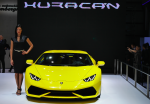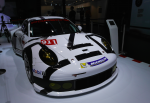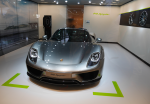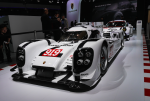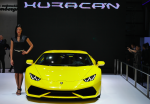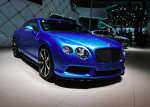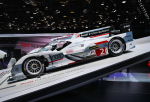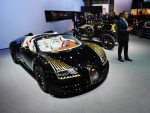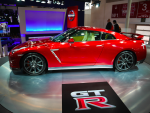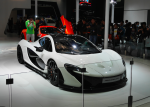 The Beijing auto show is in full swing in the Chinese capital city. The focus of many carmakers has ostensibly been on sustainability and environmentally-friendly performance, which explains the presence of many hybrids and electric cars on the stands. With the green side of the spectrum covered, automakers brought out the red hot: nearly all brought to the fore the machines that dreams are made of: the supercars. The world’s foremost performance brands unveiled the next generation of cars that will conquer road and racetrack:
The Beijing auto show is in full swing in the Chinese capital city. The focus of many carmakers has ostensibly been on sustainability and environmentally-friendly performance, which explains the presence of many hybrids and electric cars on the stands. With the green side of the spectrum covered, automakers brought out the red hot: nearly all brought to the fore the machines that dreams are made of: the supercars. The world’s foremost performance brands unveiled the next generation of cars that will conquer road and racetrack:
Porsche 918. Who says that a supercar can’t be a tree-hugger as well? Certainly not Porsche, which built its latest super sports car with a hybrid powertrain. The 918 Spyder combines a 4.6-liter V8 with two motors. The electric motors allow emissions-free driving for up to 30 km, while still accelerating to 100 kph in 6.2 seconds. When engaged, the 608-hp V8 engine combines with electric propulsion to warp to 100kph in just over 2.5 seconds, to 200 kph in 7.3 seconds, on its way to its 342 kph top speed.
 Porsche 919. Even for its assault on the World Endurance Championship, including the Le Mans 24 Hours race, Porsche is getting a boost from hybrid technology. The 919 prototype is the most complex race car that the company has ever built. Technology that will be applied to Porsche’s road cars will be developed from the 919. These will include the two different energy recovery systems and a downsized, turbocharged engine. 919 uses a 2.0-liter V4 engine that uses direct injection and a single turbo. An electric generator capture energy from the exhaust system, while a second system is able to convert kinetic engine from the brakes and store into lithium-ion battery packs.
Porsche 919. Even for its assault on the World Endurance Championship, including the Le Mans 24 Hours race, Porsche is getting a boost from hybrid technology. The 919 prototype is the most complex race car that the company has ever built. Technology that will be applied to Porsche’s road cars will be developed from the 919. These will include the two different energy recovery systems and a downsized, turbocharged engine. 919 uses a 2.0-liter V4 engine that uses direct injection and a single turbo. An electric generator capture energy from the exhaust system, while a second system is able to convert kinetic engine from the brakes and store into lithium-ion battery packs.
 Porsche 911 RSR. This car will race in the GT (production-car based) class of the World Endurance Championship. Based on the seventh-generation 911 sports car, the 911 RSR features a 470 hp flat-six 4.0-liter engine mated to a six-speed paddle-shift racing gearbox. Carbon fiber front and ream bumpers, front and rear deck lids, doors, underbody, wheel arches, rear wing, dashboard and center console help cut down the weight of the car and lower its center of gravity. Even the battery is made from lithium ion to optimize weight distribution.
Porsche 911 RSR. This car will race in the GT (production-car based) class of the World Endurance Championship. Based on the seventh-generation 911 sports car, the 911 RSR features a 470 hp flat-six 4.0-liter engine mated to a six-speed paddle-shift racing gearbox. Carbon fiber front and ream bumpers, front and rear deck lids, doors, underbody, wheel arches, rear wing, dashboard and center console help cut down the weight of the car and lower its center of gravity. Even the battery is made from lithium ion to optimize weight distribution.
 Lamborghini Huracan. The successor to Lamborghini’s bestseller, the Gallardo, makes its Asian debut at Beijing. The Huracan packs a 5.2-liter naturally-aspirated V10 engine with 610 hp, making it capable of acceleration to 100kph in 3.2 seconds, with a top speed of more than 325 kph. Looking like a stealth fighter for the road, the low-slung Huracan is crafted from carbon fiber and an aluminum space frame.
Lamborghini Huracan. The successor to Lamborghini’s bestseller, the Gallardo, makes its Asian debut at Beijing. The Huracan packs a 5.2-liter naturally-aspirated V10 engine with 610 hp, making it capable of acceleration to 100kph in 3.2 seconds, with a top speed of more than 325 kph. Looking like a stealth fighter for the road, the low-slung Huracan is crafted from carbon fiber and an aluminum space frame.
 Bentley Continental V8 S. One of the ultimate Gran Turismo cars, the Continental GT coupe V8S packs a 4.0-liter twin-turbo V8 engine, tuned for more than adequate horsepower: 521 hp to be exact, as well as 680Nm of torque. The drive is channeled through an eight-speed automatic to all four wheels. Belying its massive 2295 kg curb weight, the Bentley can rocket to 100kph in a tick over 4.3 seconds, and on to a 309 kph top speed.
Bentley Continental V8 S. One of the ultimate Gran Turismo cars, the Continental GT coupe V8S packs a 4.0-liter twin-turbo V8 engine, tuned for more than adequate horsepower: 521 hp to be exact, as well as 680Nm of torque. The drive is channeled through an eight-speed automatic to all four wheels. Belying its massive 2295 kg curb weight, the Bentley can rocket to 100kph in a tick over 4.3 seconds, and on to a 309 kph top speed.
 Audi R18 e-tron quattro. This car is definitely not for minors, as it packs a 4.0-liter V6 turbodiesel power plant mated with a hybrid system that uses a flywheel to store kinetic energy. The diesel engine generates more than 537 hp for the rear axle, with the hybrid system feeding 230 hp to the front axle. It’s no surprise that lightweight race car has won back-to-back world championships in 2012 and 2013.
Audi R18 e-tron quattro. This car is definitely not for minors, as it packs a 4.0-liter V6 turbodiesel power plant mated with a hybrid system that uses a flywheel to store kinetic energy. The diesel engine generates more than 537 hp for the rear axle, with the hybrid system feeding 230 hp to the front axle. It’s no surprise that lightweight race car has won back-to-back world championships in 2012 and 2013.
 Bugatti Black Bess Vitesse. Bugatti chose Beijing for the world premiere of the fifth model of its six-part super-exclusive “Les Legendes de Bugatti” (Bugatti Legends) Edition. Dubbed “Black Bess,” the black supercar takes its name from the legendary 1912 Type 18, driven by Ettore Bugatti and French aviation pioneer Roland Garros. The 2014 Black Bess is based on the Veyron 16.4 grand Sport Vitesse. Its 8-liter W16 engine generates 1188 hp and 1500 Nm of torque. (Yes, the decimal places are correct.) The world’s fastest production roadster, Black Bess can rocket to 100 kph in 2.6 seconds, and can cruise at 408 kph with the roof down.
Bugatti Black Bess Vitesse. Bugatti chose Beijing for the world premiere of the fifth model of its six-part super-exclusive “Les Legendes de Bugatti” (Bugatti Legends) Edition. Dubbed “Black Bess,” the black supercar takes its name from the legendary 1912 Type 18, driven by Ettore Bugatti and French aviation pioneer Roland Garros. The 2014 Black Bess is based on the Veyron 16.4 grand Sport Vitesse. Its 8-liter W16 engine generates 1188 hp and 1500 Nm of torque. (Yes, the decimal places are correct.) The world’s fastest production roadster, Black Bess can rocket to 100 kph in 2.6 seconds, and can cruise at 408 kph with the roof down.
 Nissan GTR. The legendary GTR gets its introduction to China at Beijing. The car debuts with the 370Z sports car, as the proponents of the Nismo brand. Nissan is expanding its brand appeal to sporty vehicles, and the Nismo motorsport-based performance vehicles may also make its way to other markets, including the Philippines. The GTR’s 3.8-liter twin-turbo V6 has been tuned to a jaw-dropping 600hp and 652 Nm of torque, using racing-derived turbochargers. Suspension has been upgraded to produce more grip from the 20-inch bespoke Dunlop tires.
Nissan GTR. The legendary GTR gets its introduction to China at Beijing. The car debuts with the 370Z sports car, as the proponents of the Nismo brand. Nissan is expanding its brand appeal to sporty vehicles, and the Nismo motorsport-based performance vehicles may also make its way to other markets, including the Philippines. The GTR’s 3.8-liter twin-turbo V6 has been tuned to a jaw-dropping 600hp and 652 Nm of torque, using racing-derived turbochargers. Suspension has been upgraded to produce more grip from the 20-inch bespoke Dunlop tires.
 McLaren P1. McLaren’s successor to the legendary F1 features technology that is just as advanced as the F1’s was in its day. The P1 supercar uses a hybrid system to reduce emissions and also boost performance to make the car faster. The P1 can rocket to 200 kph even faster than the F1. The P1 driver can switch driving mode from normal all the way to race, to alter the car’s suspension and drivetrain behavior. All 375 P1s have been pre-sold.
McLaren P1. McLaren’s successor to the legendary F1 features technology that is just as advanced as the F1’s was in its day. The P1 supercar uses a hybrid system to reduce emissions and also boost performance to make the car faster. The P1 can rocket to 200 kph even faster than the F1. The P1 driver can switch driving mode from normal all the way to race, to alter the car’s suspension and drivetrain behavior. All 375 P1s have been pre-sold.
 Ferrari California T. Ferrari equals Formula One, and with the shift to turbo power in F1, it’s no coincidence that the Italian thoroughbred is also introducing a new generation of turbo engines.
Ferrari California T. Ferrari equals Formula One, and with the shift to turbo power in F1, it’s no coincidence that the Italian thoroughbred is also introducing a new generation of turbo engines.
- Lamborghini Huracan on display
Disclaimer: The comments uploaded on this site do not necessarily represent or reflect the views of management and owner of Cebudailynews. We reserve the right to exclude comments that we deem to be inconsistent with our editorial standards.




